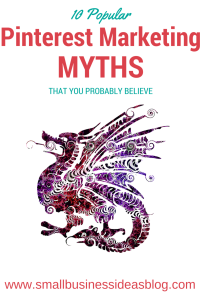 Most people know that visuals are becoming increasingly more important for online marketing.
Most people know that visuals are becoming increasingly more important for online marketing.
Studies show that adding visuals can increase views of your content by up to 96%.
But despite all the research on visual content marketing, a lot of people still aren’t using visuals in their content or aren’t marketing their visual content optimally.
Through the years, I’ve studied visual content and the channels in which visual content is promoted.
And I’ve found that there are a lot of myths on how to do use visual content effectively.
Here are 10 Pinterest myths that many people still believe. Are you guilty of believing these popular visual marketing myths?
Myth #1 – Due to Pinterest’s Smart Feed Algorithm, When You Pin Doesn’t Matter Too Much
Pinterest implemented it’s smart feed algorithm which displays older pins to users, even if they are a day old or older. So even if you pin something during non-peak times, it can still get a good amount of exposure due to how Pinterest displays pins to people.
So does this mean that old advice to pin during peak times in the evening is no longer true?
A lot of people think so, but let’s take a closer look…
While it may be true that most people are on during the evening, Pinterest doesn’t function like Twitter, especially now that it has implemented its Smart Feed algorithm.
Pinterest seems to know that people can pin good content at any time during the day, including days and times when traffic is lower than average.
And Pinterest does want to display high quality pins to its users. Quality pins keep users engaged and encourages them to keep returning to the site.
While Pinterest does display recent pins, it’s not a 100% real time feed like Twitter’s feed. In fact, many images that it shows you will be from the day before or older.
When I log into my Pinterest account and click on the first few images in my feed, all of the images in the top row are from the previous day.
Here’s how you can check your own feed.
1) Log into Pinterest. You should see a bunch of pins on your feed after you log in.
2) Click on any pin you want to inspect
3) Notice the date that the image was pinned (the pin in this example was at the top of my feed, but it was pinned yesterday)
While some pins are shown in real time, you’ll notice that many are not. At the top of my feed, some pins were from within the past few hours but some pins were as old as 7 days old.
Anna Bennett is a Pinterest expert at White Glove Social Media who’s grown her own Pinterest following to over 30,000 and manages Pinterest accounts for multiple clients. I asked her if the old advice about pinning in the evenings is still applicable now that Pinterest is using smart feed and here is her response:
Yes, it still matters.
Even though Pinterest has changed the way they show pins you still need to be mindful of when you think your target audience might be on Pinterest and where they live.
Your Pinterest analytics under “Your Audience / Demographics” will reveal where your followers reside so you can factor in time zones. So for example, if the majority of your users live in New York you want to pin in the evenings starting at 5 p.m. EST.
From my experience, regardless of who your audience is to pin your images in the evening.
Remember that there isn’t a lot of engagement on Pinterest during holiday seasons and long weekends. Again this is common sense because they are most likely busy preparing and celebrating.
While some pins aren’t displayed in real time, a lot of pins still are. So to get the best results, the old rule of thumb still applies. You should still pin in the evenings when most people are on Pinterest.
And let Pinterest display the pin to people who are on at other times.
When I look at my own feed, I see that when I pin something new, some people are re-pinning it right away. Here are a couple of pins that got re-pinned and favorited within an hour.
If you are not going to be online or working in the evening, you can use a tool like Buffer to schedule your pins.
Tip #1: So when should you pin an image? Pinning in the evenings is still optimal if you want to reach the most people.
Pinterest will also display your pin to other people long after you originally pinned it, if it is popular, including to people who are on during non-peak times.
Myth #2 – Only Women’s Stuff Does Well on Pinterest
A lot of people think that since most of Pinterest’s users are women that only niches that cater to women’s interests do well on Pinterest.
However, one of the things that Pinterest has focused on in an effort to grow and monetize the site is growing it’s male audience.
For example, in 2014, Pinterest introduced guided search, which displays search results based on the gender of the user. This feature and other changes have resulted in a 73% growth in male users in 2014.
The number of males using Pinterest is growing faster than new female users. And even though a majority of users on Pinterest are female, Pinterest already has a large male user base.
Tip #2: Even if you are in a niche that caters to men’s interests, Pinterest is worth examining. Before your write off Pinterest as a marketing channel, do a quick search for similar users and pins to see if Pinterest users are interacting with content that is targeted towards your audience.
Myth #3 – Creating Visuals is Too Difficult or Costly
Despite all the data on the effectiveness of using visuals, many businesses still aren’t using visuals in their content marketing.
One likely reason is that some people think that creating visuals is too difficult, time consuming or costly. People that blog often and aren’t active on sites like Pinterest, Instagram or Google Plus might not feel like adding visuals to their blog post is worth the time.
Sites like Pixlr and Buffer Pablo make image editing easy. But it still takes some time to learn how to use these tools and create visuals with them.
However, smart marketers know that creating visual content doesn’t have to be costly or time consuming.
Some people like to add a visual header to each blog post so that it can have at least some chance of getting shared on visual social media channels like Pinterest or Google Plus.
Perhaps one of the easiest ways to create visual headers consistently is to create a template that you can keep using and just change the background image.
You can even get free images that you can use as backgrounds from sites like Pixabay.
Another important thing to note is that as you create more and more visuals, you will be able to create them faster and more efficiently.
Tip #3: Invest the time to create visual content. With the tools available today, it doesn’t take a lot of time and can be done inexpensively.
Myth #4 – Pinterest Won’t Work in My Niche
A lot of people think that Pinterest only works for things like food, women’s clothes or arts and crafts. While these niches are some of the obvious winners on Pinterest, you may be surprised at some niches that are doing well on Pinterest.
A lot of people might be surprised to hear that real estate agents can benefit from marketing on Pinterest.
Bill Gassett is the #1 real estate agent in all of New England and a proficient social media marketer. He has grown a following of thousands on Twitter, Google Plus and other social media channels but said that Pinterest was his top social media referrer.
I reached out to Bill to ask about his experience with Pinterest and he provided this advice:
If I were to tell you what the #1 traffic source is to my real estate website I would bet my shirt that you would get it wrong. Most people would probably guess Facebook or maybe even Twitter. You would be off by a long shot! So what is the top social media site that most people are missing a boat load of traffic from a lack of participation? Drum roll please……it is Pinterest! Many people incorrectly assume that Pinterest is only good for pinning items like pocket books, make-up and the next hot dress hitting the fashion scene. This is so wrong! Pinterest has grown by leaps and bounds and one of the fastest growing segments is from those who are promoting their business content.
Every Monday I publish and article from my Massachusetts Real Estate Blog to Pinterest. Week in and week out Pinterest rules my analytics as a traffic source. It is in fact at least five times better than my next closest social site. You are probably thinking to yourself how is the traffic so good? One of the major keys to being successful on Pinterest is having exceptional graphics. One of the sites I love for putting together an vivid graphic is Canva. With Canva you can create graphics that look as close as you can get to a professional designer. Want a taste of what I am talking about? Take a look at my board filled with Pinterest Real Estate Pins. Pay careful attention to the pins that have the Maximum Real Estate Exposure logo. These are pins that have been created with Canva.
As a real estate agent there are quite a few other things you can do to get noticed on Pinterest including having a tall graphic, joining group boards, applying for rich pins and getting a plugin that allows pinning right from your own website. You can see an article here on using all of these Pinterest real estate marketing tips. Once you get the hang of Pinterest and start connecting with others you will see your traffic grow and grow.
Tip #4: Pinterest has a large and diverse audience that is continuing to grow. Be sure to explore your niche on Pinterest and see if other pins are doing well on this channel instead of just assuming that it won’t work.
Myth #5 – I Don’t Have Time for Pinterest
Pinterest is one of the easiest social media channels to participate in. In fact, I can manage my Pinterest account in just a few minutes a day.
Unlike other social media channels, you don’t even have to log in every day. Popular pins can get re-pinned for months after they were first shared. So you don’t even have to log on every day to get traction from Pinterest, although consistency is still encouraged.
Asides from using Pinterest for traffic generation and building brand awareness, I use Pinterest as a way to organize useful resources that I find. As a blogger, keeping track of useful blog posts and data is something that I need to do anyways.
And Pinterest makes it easy to do.
Another important thing to note is that Pinterest is not a very “social” channel. In other words, people are mostly just pinning things and not sending messages to other members or even commenting.
The lack of social chatter on Pinterest can actually be a good thing as it reduces the chance that Pinterest will become a time consuming distraction.
Tip #5: If you haven’t explored Pinterest yet, try spending just a few minutes a day on it. You might be surprised to find how easy and even fun it can be.
Myth #6 – I’m not a graphic designer, so I can’t market on Pinterest
Your visuals don’t have to be perfect works of art for you to do well on Pinterest. In fact, some of the most popular images are blurry photos or even amateur level graphics.
The most important thing about your visual is the message that it conveys.
This pin by Mashable, for example, contains only white text on a black background, but got pinned over 800 times:
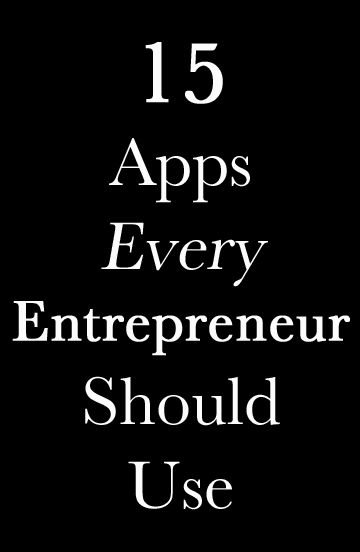
Source: https://www.pinterest.com/pin/72972456439511344
If you are not a graphic designer, you can still create great looking visuals using the tools available online:
Canva – You can use the templates in Canva to create images that look like they were professionally designed. Just pick an image you like and replace the text with your own. Many designs are free, but the paid ones are inexpensive and can cost less than stock photos.
PicMonkey – Another neat and free online graphics tool is PicMonkey. With this tool, you can easily add text, borders and other effects to create your own images.
Pixlr – With just a little graphic design skill, you can use Pixlr to edit your images. Pixlr is similar to Photoshop with much less features. It is free and can be used online.
Tip #6: Try to make your visuals look good, but don’t let it stop you from doing visual content marketing. The tools that are available now make it easy to create attractive visuals and many of these tools are free and easy to access.
Myth #7 – Use Hash Tags in Your Pin Descriptions
Hash tags were a somewhat popular feature on Twitter and studies showed that including them in your tweets helped increase the visibility of your tweet. But what about using hashtags on Pinterest?
Ann Smarty is the founder of MyBlogU, a collaborative blog promotion tool, and Viral Content Buzz, a social media management tool. In a recent Moz article, Ann studied how hash tags worked on different social media channels.
One interesting thing she noted is that when you do a search for a keyword phrase on Pinterest, none of the results that show up have hash tags.
In other words, hash tags don’t seem to help improve visibility in Pinterest searches at all. You can try a few Pinterest searches to see for yourself.
Here’s what Ann had to say about using hashtags on Pinterest:
Pinterest search doesn’t support hashtags, so I don’t really know why anyone would want to use them. Try searching for a hashtag, such as #love, Pins with the word “love” in the description will show up in the results, but so will Pins that have the word “love” hidden in the URL/product page/file name… So I am not really sure how hashtags may increase a pin visibility…
Pinterest search does not support hash tags so at the moment, and hash tags don’t seem to serve much purpose on Pinterest. Instead, Pinterest looks at keywords in the description, pin or board name and URL.
So if you want your boards or Pinterest profile to rank, just use your keywords in your description and board name.
Tip #7: Hash tags don’t seem to make much difference on Pinterest, but if you want to get traffic from Pinterest search, be sure to include your keywords in the board and pin descriptions and title.
Myth #8 – Once You’re Done Sharing a Pin, You Can Forget About It
While doing some research for visual content marketing myths, I came across an article by Caitlin Bacher that revealed an interesting Pinterest tip that I hadn’t heard about before.
Pinterest’s Smart Feed algorithm looks at things like the number of pins and favorites on your pins to determine how popular your Pinterest boards are.
A couple of social media marketers deleted some of their unpopular pins from their boards and noticed an improvement in traffic to their accounts.
While it’s normal to leave unpopular items pinned, you may want to consider deleting anything that hasn’t gotten re-pinned so that Pinterest will recognize you as a popular pinner.
I saw this post on Instagram from Melyssa Griffin from The Nectar Collective:
https://instagram.com/p/4hmVmCmrRM/
Pinterest has an algorithm that’s based on something they call “The Smart Feed.” This algorithm is meant to display pins as “best” first rather than “newest” first. The reason why it’s important to delete pins with zero (or few) repins is simple: because it will trick Pinterest into thinking you are one of their “best” pinners. To Pinterest, anyone who gets at least one repin on their pins is in line with being a Power Pinner, meaning that you likely pin quality content that your followers seem to like (because they are repinning it). Therefore, your pins will show up at the top of The Smart Feed and get you even more repins than before. This isn’t hocus pocus, I promise! I’ve actually suggested this to more than 200 students in my course, Pinfinite Growth, and continually hear that it gives my students a powerful boost in repins and followers. It’s definitely something that I recommend adding to your Pinterest arsenal.
Tip #8: Consider deleting pins that haven’t gotten re-pinned after a few months if you want to improve the popularity of your boards.
Myth #9 – If You Pin Too Often, People Will Unfollow You
One Pinterest tip that I see often is to not pin too often so that your followers won’t get annoyed and unfollow you.
I’ve seen no evidence to support the notion that if you pin often, you will lose followers. In fact, most Pinterest marketers are pinning less frequently than optimal.
This tip likely came into existence because some Pinterest users pin a lot of images thinking that more pins will result in more overall exposure.
Pinning a lot of images is fine as long as the pins resonate with your audience. In other words, as long as the quality is good, you shouldn’t feel like you have to hold back.
Note also that since Pinterest has implemented the smart feed algorithm, your followers are less likely to get inundated by your pins.
Mary Lumley from Born to Be Social is a Pinterest marketing consultant who’s grown her Pinterest following to over 40,000. Here’s what she recommends for pinning frequency:
The more active you are on Pinterest, the better the long-term results. I recommend to pin at least 5 times a day at different times. Since the introduction of Pinterest’s smart feed the quality of pins is a lot more important. The best quality pins get moved to the top of the feed, so you are unlikely to overwhelm your followers with too many pins. Pin as many quality pins as you have time for!
Tip #9: Pin consistently and remember that most Pinterest marketers are pinning less frequently than is optimal. There’s no magic number for how often to pin, so do what makes sense for your audience as long as you are pinning things that your followers engage with.
Myth #10 – Pinterest Doesn’t Drive Much Traffic
A lot of online marketers are still ignoring Pinterest because they don’t think it can drive much traffic.
A recent study by Shareaholic shows that Pinterest is the second leading social media traffic referrer, exceeded only by Facebook. In fact, Pinterest referral traffic exceeds Twitter and other social media channels by more than 5x.
Pinterest is underrated as a traffic driver in many niches, including the marketing niche.
Tip #10: Don’t underestimate Pinterest as a traffic source. Spending just a little time each day on Pinterest and adding visuals to your content could result in some long term traffic gains.
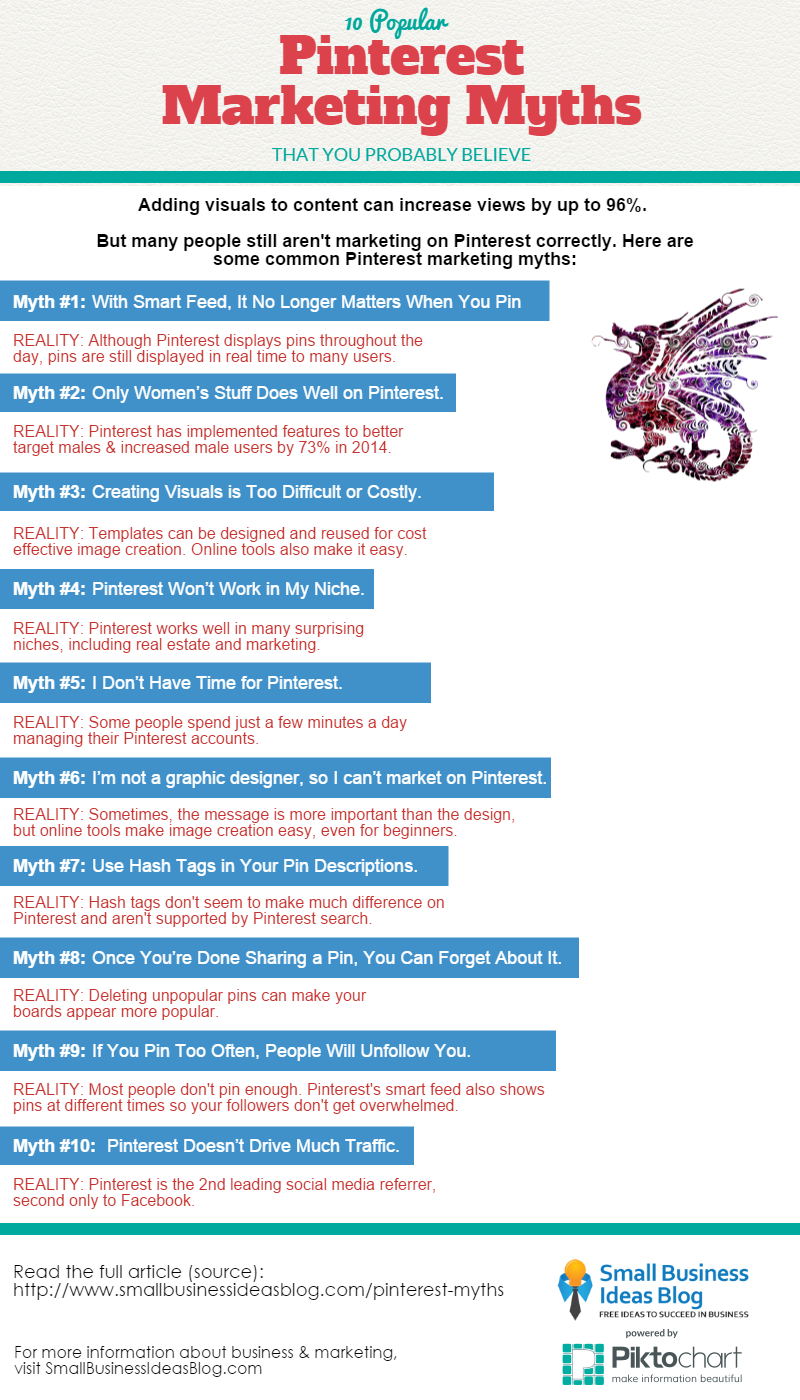
So what do you think? Are any of these Pinterest marketing myths keeping you from success?

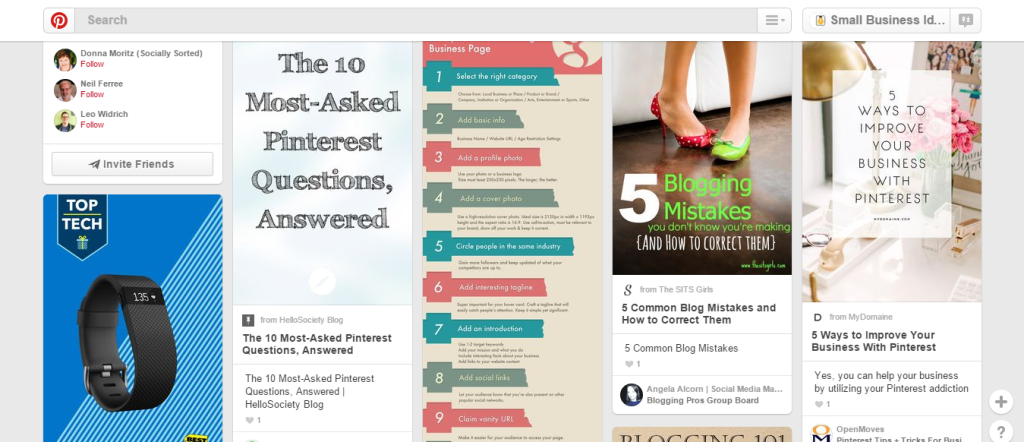
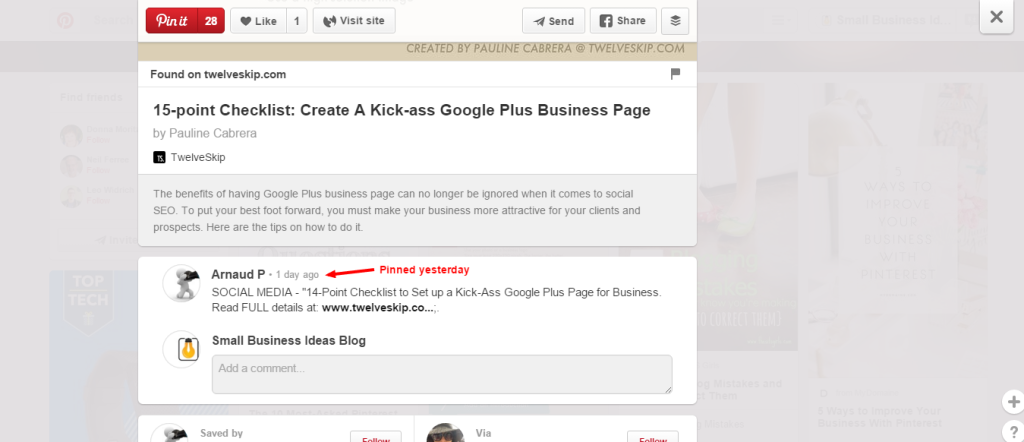
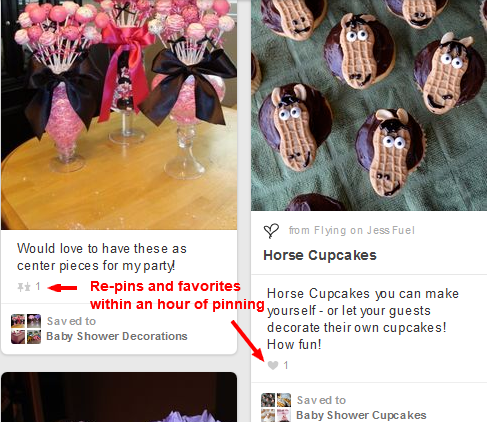
Thanks for including me in your post Brian. Lot’s of great Pinterest tips from fellow Pinners!
Welcome, Anna – thanks for contributing to this!
Great collection of tips! Thanks for the mention, Brian 🙂
Very welcome, Mary!
As a professional, I am new into SEO and social media industry after an intensive online course. These tips are really good and couple of these I already knew and was implementing and some of these are really new to me. Will be following your suggestions and will look into the results. Thanks for sharing your knowledge with us.
Welcome, Rajati – I’m glad you found it useful!
Great post! I’m sharing with my readers on FB.
Awesome – thanks Kate!
Wow! This is great Brian
It’s fortuitous for me that you’ve posted this article because on Monday we started posting on Pinterest, for the first time.
Your post is comprised of 9 myths, but in reality it is a mini tutorial, so I will take on board each of your tips. I am particularly encouraged by your point that Pinterest it is not just a platform for women. More guys are now joining which is great.
It’s also good to know that more mainstream niches (eg real estate) can be promoted, and was absolutely gobsmacked when I saw that it is now second only to Facebook in terms of social media referring
Great post, thanks!
Thanks, Kim! Pinterest is a great channel to be on for sure and there are definitely enough men on it that it deserves consideration. I’ll probably be increasing activity even more on Pinterest myself.
Hey Brian,
Recently, I have been monitoring how to make the most of Pinterest.
I had the believe that only visual-based niche will do well with the Pinterest until I discover that even a freelance writer can maximize his exposure in this social platform.
Yes, with the use of good featured image and attractive titles he can generate more traffic.
Thanks for clearing up these myths!
Hi Sunday,
Yes, Pinterest can drive traffic for many more niches than most people realize including real estate and business. There are already a lot of people on Pinterest so it is a large network with lots of opportunities.
Great Post sir..i interest to start marketing for my website using pinterest.. What are the advantages of pinterest. which i choose pinterest or flickr?
Pinterest seems to have grown faster than Flickr. You can always try them both out.
Thanks for sharing such a great article.It is really useful to start marketing.
Welcome, Arthur!